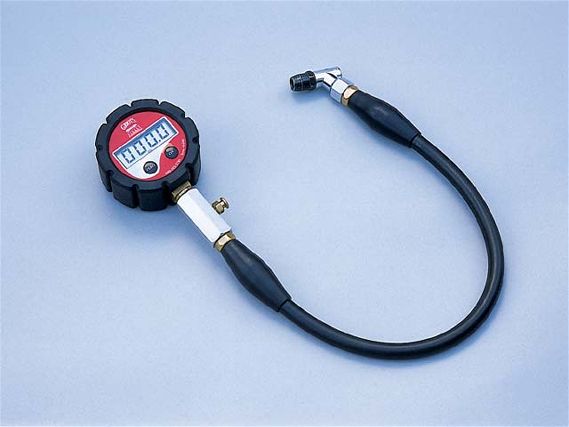 | Griot's Garage Professional Tire Gauge
| Griot's Garage Professional Tire Gauge
In the July 2001 issue, european car tested 14 tire pressure gauges, a sample representing almost the whole spectrum of what an enthusiast might buy, be handed at a show, borrow at the track or find rolling around in the glovebox of his idiot cousin's Fairlane. The most expensive gauge tested was $69.95. We didn't like it as well as a $19.95 Accutire digital gauge from Performance Products, which had a resolution of 0.5 psi and was one of only three to track our ANSI Grade 1A master gauge perfectly from 5 psi to 45 psi. We were aware of more expensive gauges, but the next step up in function, at least that we found in our search, was in the neighborhood of $250. It read to 0.1 psi, had built-in memory functions and would probably be great for people racing used Porsche Cup cars. For the rest of us, it was irrelevant.
Or was it? If a 1-psi change can make a measurable difference in lap times, doesn't a racer need more precision? What's the step point? If the gauge says 29.5 psi, tire is probably somewhere between 29.01 psi and 29.99 psi, but you don't know where for sure. Tires that measure 0.5 psi apart could be almost 1.0 psi apart. I was going drag racing, too, and our slicks' pressures were in the neighborhood of 7 psi. Half a psi is a lot when you have only 7.
In between many sleepless nights on account of the question, I happened to go to the track with a guy who had worked for an IMSA prototype race team. He had a digital gauge he had made from refrigeration test equipment that read to 0.1 psi and cost about $100. I searched for a similar gauge and couldn't find one. Surprisingly few months went by before Griot's Garage announced a new digital gauge with a range from 0-60 psi, 0.1-psi precision and a price about the same as the racer's homebrew unit. Of course, I had to try it.
The Griot's Garage gauge has a large, digital display so it should be readable even by "vintage" racers. The gauge has a hose and swivel fitting, making the connection to the valve stem easy, and a bleed valve aids rapid, precise adjustments. The gauge body is housed in rubber to protect the tool from drops and protect fine paint from the gauge. The only special instruction is the gauge must be zeroed when turned on and if the no-pressure reading drifts, which happens only slowly. In practice, it's not even an inconvenience.
In my opinion, it would take a true idiot to find a way to misuse this gauge or get a wrong reading with it. Due to its bulk, it's probably not something you want taking up space in your glovebox. It belongs in the top drawer of your toolbox, not bouncing around among the wrenches.
Is the Griot's Garage Professional Digital Tire Gauge the best choice to make sure your commuter ride is in the safe zone? Probably overkill. But it will give you that last ounce of precision and confidence you need to set up your track car perfectly, and I haven't seen a better price for this level of performance.
